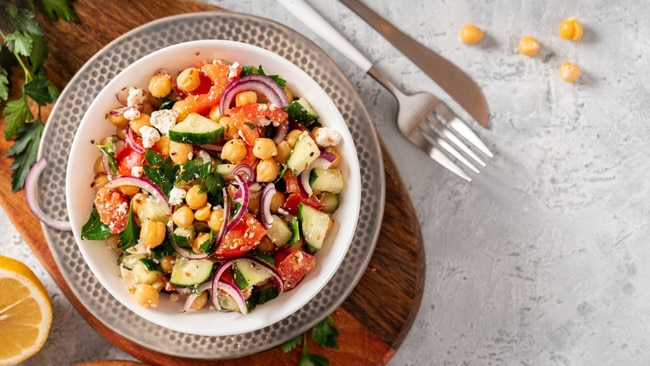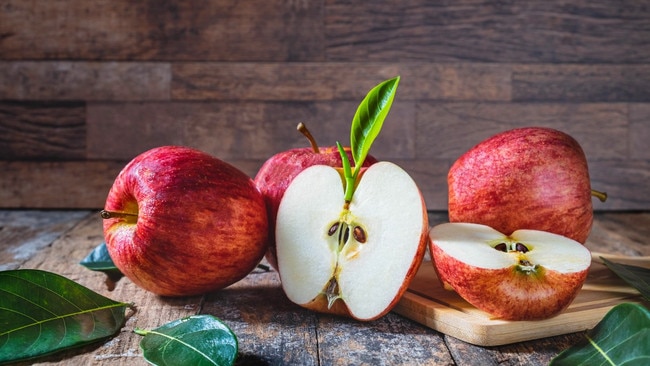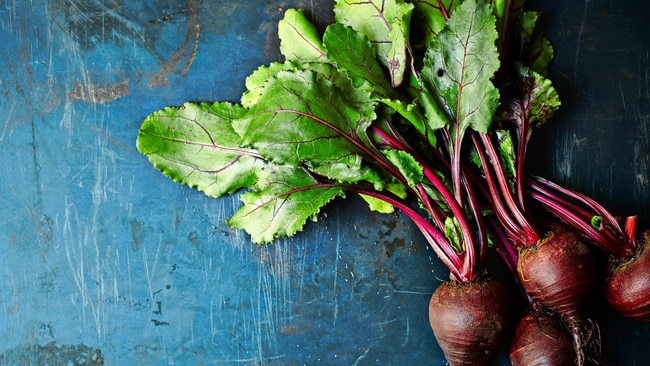How to make your food more nutritious with these 23 tiny tweaks
From adding chickpeas to your meals to microwaving your veg, these expert tips will boost your health.

Most of us have periods when we find ourselves eating the same meals week in, week out, which means we are not always getting the optimum intake of nutrients, fibre and beneficial plant compounds we need.
“Variety always underpins the healthiest diets,” says Dr Linia Patel, a researcher in the department of clinical sciences and community health at the Universita degli Studi di Milano in Italy and a spokeswoman for the British Dietetic Association.
“Making even small changes to your food intake or the way you cook can enhance the overall profile of your diet.” Here’s how to do it.

1. Add three tablespoons of chickpeas to a meal just once a week to reduce your risk of bowel cancer
Eating one 40g portion of dried pulses (about three tablespoons when cooked) a week could decrease your risk of colon cancer by 21 per cent compared with eating no pulses, according to a study published in February in the European Journal of Clinical Nutrition. Patel, a lead author on the paper, says that adding pulses to soups, casseroles and salads even once a week will improve your health. “Pulses contain fibre that acts as food for your gut microbiota,” she says. “But they also contain bioactive compounds known as phenolics that are believed to play a role in the prevention of colon cancer.”
2. Add a spoonful of honey to yoghurt to improve its probiotic powers
Yoghurt is known to provide beneficial probiotic bacteria that promote digestive health and have been linked to better mood and cognition. But adding a tablespoon of honey - particularly if it is clover-derived – to natural unsweetened yoghurt could boost its probiotic powers. The honey helps the beneficial bacteria to survive their journey through the digestive system, according to two recent studies in The Journal of Nutrition.
“We found that one tablespoon of honey in a serving of yoghurt helps support probiotic survival,” says Hannah Holscher, associate professor in the Department of Food Science and Human Nutrition at the University of Illinois Urbana-Champaign, who led the research.

3. If you enjoy a morning coffee, wait until after breakfast to drink it
A slug of strong black coffee first thing might help you to wake up but could backfire by limiting your body’s ability to tolerate the sugar in your breakfast, according to scientists at the University of Bath. For a paper published in the British Journal of Nutrition, Professor James Betts found that drinking black coffee before breakfast increased the blood-sugar spike after the meal by 50 per cent. “Put simply, our blood-sugar control is impaired when the first thing our bodies come into contact with is coffee,” Betts said. “We can improve this by eating first and drinking black coffee later if we feel we still need it.”
4. Brush tomatoes with oil before cooking to maximise lycopene
“Tomatoes are a good source of the potent antioxidant lycopene, which has been linked to a reduction of some cancers, cardiovascular disease and neurodegeneration,” says Ian Marber, a nutrition therapist. “Plenty of studies, including one at Cornell University, have shown that heating or cooking tomatoes increases the bioavailability of lycopene.” Even more beneficial is to brush them with a dash of oil before cooking, which helps to separate the lycopene from carrier proteins so that it is more easily absorbed. Researchers reporting in the Journal of Culinary Science & Technology showed that lightly steaming oil-brushed tomatoes produced the highest amount of lycopene.
5. Steamed carrots are better than raw …
Eating a raw carrot stick might seem virtuous but cooking this vegetable is better for you, according to a study published in the Journal of Agricultural and Food Chemistry, apparently because the heat increases its levels of antioxidants. A study in the journal Foods showed that boiling carrots until just tender preserved the most carotenoid antioxidants, while steaming them for a maximum of 10 minutes enhanced the potassium content.
6. … and eat the carrot leaves – they’re full of vitamin C
According to a study published in August in the journal Food Science & Nutrition, “fresh carrot leaves have a higher vitamin C content than many leafy vegetables and even its own family, parsley”. Like the root vegetable itself, carrot leaves also provide some vitamin A, B6 and K (vital for bone health), folate, manganese and thiamin. Strip the leaves and chop them as a garnish.
7. If you are going to have brown bread, make it rye
“Rye bread is super high in fibre, which makes it great for gut health and digestion,” says Eli Brecher, a registered nutritionist. One study published in The Journal of Nutrition showed that a regular intake of rye bread, made with flour from whole rye kernels, helped to maintain bowel regularity, a risk factor for bowel cancer, better than other varieties including wholewheat. And Swedish researchers who asked midlifers to substitute their regular wheat-based bread with high-fibre rye-based varieties found that the rye bread seemed to help them to lose weight and body fat more effectively.
8. Add raw shredded kale to a salad to bolster nutrient intake
Yes, it’s a superfood, but boiling, steaming, microwaving, pressure-cooking or vacuum-cooking kale was shown by food scientists at the Universidade de Vigo in Spain to reduce its total antioxidant and mineral content significantly, with reductions in levels of calcium, potassium, iron, zinc and magnesium. Cooking kale can also destroy an enzyme called myrosinase, which helps to boost its antioxidant properties. It’s best chopped or shredded with lettuce for a salad or prepared with minimal cooking such as with flash stir-frying.
9. Eat your veggies first
Eating vegetables or crudites before any protein on your plate, and saving starchy carbs such as bread and pasta until last, is one of the best ways to curb your appetite and prevent blood-sugar spikes. One study on so-called food sequencing, published in Diabetes Care, showed that eating foods in this order reduced blood-sugar spikes by a whopping 73 per cent compared with eating the same foods with either carbs or protein first. “Research shows that this prevents blood-sugar peaks and leads to higher levels of the appetite-suppressant hormone GLP-1,” says Alex Ruani, a researcher in nutrition science at University College London and chief science educator at the Health Sciences Academy.
10. Microwave green beans (and other veg) to preserve vitamins
Cooking green beans in a microwave has been shown to maximise antioxidant availability in a Brazilian study published in the International Journal of Food Science and Nutrition. “Using a microwave to cook most veg is actually a really good way to preserve the vitamins, minerals and phytochemicals compared to other methods,” Ruani says. “Because little water is used and it is very quick, the water-soluble vitamins like B and C are retained better.”

11. Eat an apple before lunch to reduce hunger levels
Munching on an apple before lunch can cut hunger levels so that you consume fewer calories at the meal. “A 2019 study from Malaysia showed that people who practised this diet trick reduced their calorie intake by 18.5 per cent - an average 166 kcal - compared to controls who didn’t eat the fruit,” Ruani says.
12. Throw chopped celery into a casserole for anti-inflammatory properties
Celery stalks contain fibre, potassium and vitamin K – which are important for healthy bones - as well as antioxidants that may have anti-inflammatory properties. However, crunching on a celery stick is not the best way to maximise nutrient intake from the vegetable, according to food technologists at the University of Murcia and the University of Complutense in Spain. They studied the effects of six cooking methods – boiling, pressure-cooking, baking, microwaving, griddling and frying – on the nutrient levels of different vegetables for a paper published in the Journal of Food Science. According to the Spanish scientists, it’s best to steam celery for five minutes, roast for ten minutes or chop into a stew or bolognese sauce to maximise the intake of beneficial nutrients.
13. Add red leaves to your salad for more healthy polyphenols
We tend to think of salad leaves as being green but throw in some red leaf lettuce for added antioxidants and other nutrients. An analysis of 23 edible leaves in Food Research International found that red salad leaves contained the highest overall amount of beneficial polyphenol plant compounds including more carotenoids, more of the red antioxidant pigment cyanidin and higher amounts of polyunsaturated fatty acids.
14. Steam spinach for 60 seconds to enhance calcium levels
Spinach is packed with vitamin C, vitamin B6, magnesium, calcium and iron but also contains oxalates that block the absorption of iron and calcium by the body. Boiling and steaming this veg for even 60 seconds has been shown by scientists at the University of Wyoming to reduce oxalate levels by up to 86 per cent so that more calcium is available for the body to absorb from spinach.

15. Add mushrooms to soups, stews and casseroles (they fill you up more than meat)
Mushrooms contain a variety of fibres that are known to slow gastric emptying and fill you up more quickly than other foods, including meat. In one study at the University of Minnesota, researchers found that people given 425g of white button mushrooms a day for 10 days reported feeling significantly less hungry and ate less in the hours after eating compared with others given the same relative quantity of beef. Substitute meat for mushrooms in soups and stews.
16. Chop or crush garlic before cooking for disease-fighting benefits
Garlic and onions contain allicin, an active compound that acts like an antioxidant and was shown in a study published in the International Journal of Food Properties to protect healthy cardiovascular function and immune function, and to ward off disease. “Garlic is the more concentrated source and allicin is released when it is chopped, sliced or crushed, but largely deactivated when cooked,” Marber says. When adding to cooking, make sure you crush it rather than add as a whole clove.
17. Add onion skin to soups and stocks to protect your heart
The tough external layers of an onion are rich in non-soluble fibre and a source of quercetin, a flavonoid substance that has been shown to help to reduce blood pressure and prevent clogged arteries, according to various studies including one published in Plant Foods and Human Nutrition. Although the brown, papery skin is inedible on its own, some of the beneficial compounds can be obtained by adding it to stocks, soups and stews, then simmering.
18. Cool potatoes before eating them to reduce blood-sugar spikes
Potatoes are an important source of vitamin C, vitamin B6, folate and iron. A downside is that they cause a blood-sugar spike. To reduce this, try mashing them with a little protein-containing food such as milk or cheese to reduce their glycaemic load or, better still, cool them after cooking. Researchers at the University of Surrey reported that serving cooked potatoes cool, or cold in a salad, changed the structure of the starch they contain so that a blood-sugar spike was less severe.

19. Use beetroot leaves to boost iron levels
Don’t discard beetroot leaves - they have a higher iron content than spinach and a higher nutritional value than the beetroot itself. Studies have also shown that the vitamin K they contain works with calcium to boost bone strength. Chop them into salads or add to stews.
20. Reheat your leftover pasta and tomato sauce to make it healthier
For research at the University of Surrey, Dr Tracey Robertson, a researcher in the department of nutritional sciences, compared the blood-sugar responses of identical meals - pasta, served with olive oil and tomato sauce - when freshly cooked, chilled, or chilled and then reheated, on a group of healthy people. Her findings, published in the European Journal of Clinical Nutrition, showed that a post-meal blood-sugar peak was smaller when the pasta was eaten cold than when it was piping hot, but that the participants experienced the smallest peak when the dish was chilled and reheated.
21. Add black pepper when using turmeric to increase absorption
Turmeric’s health status is largely down to the active ingredient curcumin, which has anti-inflammatory and antimicrobial properties. However, researchers at the State University of New York at Buffalo reported that turmeric is only about 5 per cent curcumin and that means you’d need to consume an awful lot of it to enjoy the health benefits. “If using turmeric in cooking, a tip is to add a pinch of black pepper,” Ruani says. “An active compound called piperine in the pepper was shown to increase the bioavailability of curcumin by as much as 2,000 per cent in one study in Planta Medica journal.”
22. Eat beetroot raw for more beneficial nitrates
Beetroot contains vitamin C, folate and fibre but its key health benefit is in providing nitrates. These are compounds that are converted by the body to nitrite, which relaxes and widens blood vessels and can play a role in healthy blood flow, immune function and cardiovascular function. However, since nitrates are water-soluble they can be lost when beetroot is boiled, according to Andrew Jones, professor of applied physiology at the University of Exeter. “If you don’t consume the water the root is boiled in, you would lose a lot of the nitrate,” Jones says. “Juicing raw beetroot or grating it into a salad are the best ways to eat it.”
23. Add plant milks to tea to boost gut bacteria
Reporting in the Journal of Nutrition, scientists from the University of California found that the absorption of beneficial plant compounds – known as flavan-3-ols – in tea can be boosted by 55-70 per cent when you drink it with soya or rice milk. “More of the healthful plant compounds in tea make it to the colon when consumed with plant milks,” Ruani says. “And there they are transformed into beneficial bacteria that boosts gut health.”
The Times







To join the conversation, please log in. Don't have an account? Register
Join the conversation, you are commenting as Logout